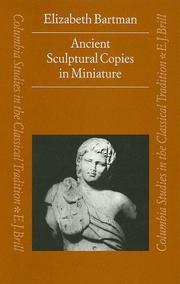| Listing 1 - 10 of 135 | << page >> |
Sort by
|
Periodical
ISSN: 02666960
Abstract | Keywords | Export | Availability | Bookmark
 Loading...
Loading...Choose an application
- Reference Manager
- EndNote
- RefWorks (Direct export to RefWorks)
Micrographics --- Copying processes --- Micrographie --- Reprographie --- Periodicals. --- Périodiques --- Copying processes. --- Micrographics.
Digital
Abstract | Keywords | Export | Availability | Bookmark
 Loading...
Loading...Choose an application
- Reference Manager
- EndNote
- RefWorks (Direct export to RefWorks)
Machinery --- Copying processes --- Writing --- Inventions
Digital
Year: 1764 Publisher: Vienne Chez Jean-Thomas de Trattnern
Abstract | Keywords | Export | Availability | Bookmark
 Loading...
Loading...Choose an application
- Reference Manager
- EndNote
- RefWorks (Direct export to RefWorks)

Abstract | Keywords | Export | Availability | Bookmark
 Loading...
Loading...Choose an application
- Reference Manager
- EndNote
- RefWorks (Direct export to RefWorks)
Information user --- Copying processes. --- Copying processes --- Library applications --- Library materials --- Reproduction --- Bibliotheekbeheer

ISBN: 9004095322 Year: 1992 Volume: vol 19 Publisher: Leiden New York Köln E.J. Brill
Abstract | Keywords | Export | Availability | Bookmark
 Loading...
Loading...Choose an application
- Reference Manager
- EndNote
- RefWorks (Direct export to RefWorks)
Beeldjes --- Figurines --- Statuettes --- Sculpture, Greek --- Sculpture grecque --- Copying --- Reproduction --- -Greek sculpture --- Decorative arts --- Small sculpture --- -Copying --- -Statuettes --- Greek sculpture --- Sculpture [Greek ] --- Sculpture, Greek - Copying. --- Figurines.
Book
ISBN: 0841209626 Year: 1982 Publisher: Washington, District of Columbia : American Chemical Society,
Abstract | Keywords | Export | Availability | Bookmark
 Loading...
Loading...Choose an application
- Reference Manager
- EndNote
- RefWorks (Direct export to RefWorks)
Chimie. (Congrès) --- Chemie. (Congres) --- Copying processes --- Colloids --- Surface chemistry
Book
ISBN: 9781935408451 1935408453 Year: 2014 Publisher: New York Zone books
Abstract | Keywords | Export | Availability | Bookmark
 Loading...
Loading...Choose an application
- Reference Manager
- EndNote
- RefWorks (Direct export to RefWorks)
The Culture of the Copy is a novel attempt to make sense of the Western fascination with replicas, duplicates, and twins. In a work that is breathtaking in its synthetic and critical achievements, Hillel Schwartz charts the repercussions of our entanglement with copies of all kinds, whose presence alternately sustains and overwhelms us. This updated edition takes notice of recent shifts in thought with regard to such issues as biological cloning, conjoined twins, copyright, digital reproduction, and multiple personality disorder. At once abbreviated and refined, it will be of interest to anyone concerned with problems of authenticity, identity, and originality. Through intriguing, and at times humorous, historical analysis and case studies in contemporary culture, Schwartz investigates a stunning array of simulacra: counterfeits, decoys, mannequins, and portraits; ditto marks, genetic cloning, war games, and camouflage; instant replays, digital imaging, parrots, and photocopies; wax museums, apes, and art forgeries―not to mention the very notion of the Real McCoy. Working through a range of theories on biological, mechanical, and electronic reproduction, Schwartz questions the modern esteem for authenticity and uniqueness. The Culture of the Copy shows how the ethical dilemmas central to so many fields of endeavor have become inseparable from our pursuit of copies―of the natural world, of our own creations, indeed of our very selves. The book is an innovative blend of microsociology, cultural history, and philosophical reflection, of interest to anyone concerned with problems of authenticity, identity, and originality.
Psychologie --- Copie --- Phénoménologie --- Utopie --- Histoire de l'art --- Impostor phenomenon. --- Copying --- Twins --- Copying processes --- Psychological aspects. --- Psychology. --- Mythology. --- History. --- Copying - Psychological aspects. --- Twins - Psychology. --- Twins - Mythology. --- Copying processes - History.
Book
Year: 1996 Publisher: Amsterdam Philadelphia John Benjamins
Abstract | Keywords | Export | Availability | Bookmark
 Loading...
Loading...Choose an application
- Reference Manager
- EndNote
- RefWorks (Direct export to RefWorks)
Book
ISBN: 3598202776 9783598202773 Year: 1989 Volume: 5 Publisher: München Saur
Abstract | Keywords | Export | Availability | Bookmark
 Loading...
Loading...Choose an application
- Reference Manager
- EndNote
- RefWorks (Direct export to RefWorks)
Graphics industry --- Archivistics --- Copying services --- Archival materials --- Archives --- Copying processes --- Reproduction --- Administration --- Management --- 930.25 --- 651.56 --- Archiefwetenschap. Archivistiek --- 930.25 Archiefwetenschap. Archivistiek --- Autographic processes --- Commercial correspondence --- Duplicating processes --- Manifolding --- Reproduction processes --- Reprography --- Typewriting --- Writing --- Copying --- Documentation --- Letter services --- Reprographic services --- Services, Copying --- Service industries --- Reproduction of archival materials --- Handbooks, manuals, etc. --- Archival administration --- Archival materials - Reproduction --- Archives - Administration --- Copying processes - Management

ISBN: 0521831652 Year: 2005 Publisher: Cambridge ; New York ; Madrid Cambridge University Press
Abstract | Keywords | Export | Availability | Bookmark
 Loading...
Loading...Choose an application
- Reference Manager
- EndNote
- RefWorks (Direct export to RefWorks)
Arguing that the scholarship on this topic has not appreciated Roman values in the visual arts, this book examines Roman strategies for the appropriation of the Greek visual culture. A knowledge of Roman values explains the entire range of visual appropriation in Roman art, which includes not only the phenomenon of copying, but also such manifestations as allusion, parody, and, most importantly, aemulatio, successful rivalry with one's models.
Aesthetics [Roman ] --- Esthetica [Romeinse ] --- Esthétique romain --- Aesthetics, Roman. --- Sculpture, Greek --- Sculpture, Roman --- Copying. --- Themes, motives. --- Sculpture [Roman ] --- Themes, motives --- Sculpture [Greek ] --- Copying --- Aesthetics, Roman --- Roman sculpture --- Roman aesthetics
| Listing 1 - 10 of 135 | << page >> |
Sort by
|

 Search
Search Feedback
Feedback About
About Help
Help News
News